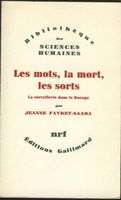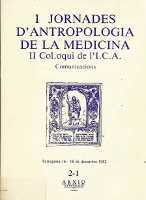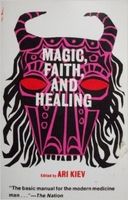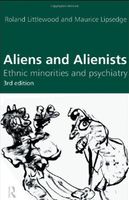Fàbrega, H., 1974. Disease and social behavior: an interdisciplinary perspective. Cambridge, Massachusetts: The MIT Press.
.jpg)
Favret-Saada, J., [1977] 1985. Les Mots, la mort, les sorts. Paris: Gallimard.

Driver, Edwin D., 1972. The sociology and anthropology of mental illness. Amherst, The University of Massachusetts Press.
.jpg)
Anon. 1982. Primeres Jornades d'Antropologia de la Medicina, 3 vols Tarragona, Arxiu d'Etnografia de Catalunya.

Goffman, Erving (1961,1968) Internados. Ensayos sobre la situación social de los enfermos mentales. Madrid: Amorrortu editores.
.jpg)
Eisenberg, L.; Kleinman, A., 1981. The Relevance of Social Science for Medicine. Dordretch , D. Reidel.
.jpg)
Douglas, M.,[1966 ] 1973. Pureza y peligro: un análisis de los conceptos de contaminación y tabú. Madrid: Siglo XXI.
.jpg)
Devereux, G. [1970] 1973. Ensayos de Etnopsiquiatria general. Barcelona: Barral.
.jpg)
Chrisman, N J.; Maretzki, T. W. 1982. Clinically Applied Anthropology. Anthropologists in Health Science Settings. Dordretch , Reidel Pub. Company.
.jpg)
Bastide, Roger, 1972. Le reve, la transe et folie. París, Flammarion.
%20(121x200).jpg)
Bastide, Roger (1967,1977) Sociologie des Maladies Mentales. París, Flammarion.
.jpg)
Loudon, J. B. Ed., 1976. Social anthropology and medicine. London: Academic Press.
.jpg)
Anterior Vitrina 4 Següent
Although the term medical anthropology was first used in the 1963 Biannual Review of Anthropology, previous state-of-the-art review articles such as Caudill's in 1952 or Polgar's in 1962 in Current Anthropology evidence the considerable development of relations between medicine, psychiatry, psychoanalysis and anthropology beyond studies of aboriginal societies or folk medicine. This is reflected in readers such as Ari Kiev's. These review articles reveal a diverse field in which applied work had considerable weight, but they take little account of non-English-language literature such as the first structuralist writings of Lévi-Strauss and the work of Ernesto de Martino, which not only critically reviewed classical concepts of magic and folk medicine but also opened up an interdisciplinary space for rethinking a specific culture-bound syndrome, tarantismo. Also not included was the Spanish-language literature of Latin America produced by such authors as Aguirre Beltrán and the considerable output stemming from the work of Henri Collomb at the Fann Hospital in Dakar, which gave rise to the journal Psychopathologie africaine and a wide range of ethnographic studies on madness in Africa. Collomb's contributions are linked to the studies by M.C. and E. Ortigues, Piault's collected volume on religion and therapeutics, Adler and Zempleni's ethnography of illness and divination in central Africa and the early writings of Lluís Mallart. This interest would later extend to Asia, in the work of Meyer and in Zimmerman's study of Hindu medicine. European ethnology, too, showed a new interest in these questions, which can be seen clearly in Jeanne Favret-Saada's (1977) pioneering anthropological study influenced by psychoanalysis and structuralism, and in the work of Loux in France and Lisón in Galicia. The development of structuralist theory by Mary Douglas and Turner's work on ritual were of key importance for many of these authors.
Interest in folk illnesses and their relation to psychiatry was also connected to the cultural debate on psychiatry that began in 1960, prompted by the work of Szasz, Laing, Cooper, Castel, Basaglia, and Goffman, as well as by that of Roger Bastide and Herzlich's presentation of the North American literature on this subject. Devereux's arrival in Paris led to the formation of a group of disciples, the best known of whom was Tobie Nathan. These lines of inquiry were parallel to the development of transcultural psychiatry.
The publication of Disease and Social Behavior by the physician and anthropologist Horacio Fabrega played a significant role in the development of North American medical anthropology beyond the mere labeling of a field. The founding of the Society for Medical Anthropology and the creation of the journals Social Science and Medicine, the German Curare - both of which are still in existence today - and the more ephemeral Bulletin d'Ethnomédecine in France, initiated a foundational period in the sense that national communities of medical anthropologists were created, each of which was represented by a major collected volume: Loudun in the United Kingdom, Retel-Laurentin in France, Seppilli's La Ricera Folklorica, and Kenny and De Miguel in Spain.
Authors such as Kleinman in the English-speaking world and Menéndez in the Spanish-speaking world have had an enormous influence in their linguistic domains, and the debates their work has generated go a long way toward explaining the genealogy of clinically applied anthropology represented by the important Culture, Illness and Healing book series and by the debates on critical medical anthropology that are illustrated in the next display case.
Herzlich, Claudine (comp.) 1970. Médecine, maladie et sociéte. París, Mouton.
.jpg)
Kiev, A., [1964] 1974. Magic, faith and healing. Studies in primitive psychiatry today. New York: Free Press.

Lisón Tolosana, C., 1979. Brujería, estructura social y simbolismo en Galicia. Madrid: Akal.
.jpg)
Kenny, Michael; Miguel, Jesús de, comps. 1980. La Antropología Médica en España. Barcelona, Anagrama.
.jpg)
Kleinman, A., 1980. Patients and healers in the context of culture. Berkeley: University of California Press.
.jpg)
Littlewood, R.; Lipsedge, M. 1982. Aliens and Alienists: Ethnic Minorities and Psychiatry. Hardmonsworth, Midd., Penguin Books.

Kiev, A., 1968. Curanderismo: Mexican-American Folk. New York: The Free Press.
.jpg)
Adler, Alfred ; Zempleni, Andras, 1975. Le baton de l'aveugle. Divination, maladie et pouvoir chez les Moundang du Tchad.
.jpg)
Aguirre Beltran, G.,[1963] 1992. Obra Antropológica VIII. Medicina y màgia. El proceso de aculturación en la estructura colonial, México: Ediciones de la Casa Chata.
.jpg)
Loux, F., [1983] 1990. Traditions et soins d'aujourd'hui : anthropologie du corps et professions de santé. París: InterÉditions.
.jpg)
López Austin, Alfredo (1980,1989) Cuerpo Humano e Ideología. Las concepciones de los antiguos nahuas México, Universidad Nacional Autónoma de México.
.jpg)
Mallart Guimerà, L., 1977. Médecine et Pharmacopee Evuzok. Nanterre, Laboratoire d'Ethnologie et de Sociologie Comparative.
.jpg)
Mallart i Guimerà, Ll., 1981. Ni dos ni ventre : religion, magie et sorcellerie Evuzok. Paris: Societè d'Ethnographie.
.jpg)
Martino, Ernesto de [1959] 1983. Sud e magia. Milan , Feltrinelli.
.jpg)
Martino, Ernesto de (1961,1994) La terra del rimorso. Contributo a una storia religiosa del sud. Milan , Il Saggiatore.
.jpg)
Menéndez, Eduardo L., 1981. Poder, estratificación y salud. Análisis de las condiciones sociales y económicas de la enfermedad en Yucatan. México, La Casa Chata.
Ortigues, MC & Ortigues . E: [1966] 1984. Oedipe africain. Paris l'Harmattan.
.jpg)
Piault, Colette, 1975. Prophetisme et thérapeutique. Albert Atcho et la communauté de Bregbo.. París, Hermann.
.jpg)
Retel-Laurentin, Anne, ed., 1983. Une Anthropologie médicale en France? Exposés et débats de la table ronde "Sante et sciencies humaines" C.N.R.S., 1980. París, CNRS.
.jpg)
Turner, V., [1967] 1980. La selva de los símbolos: aspectos del ritual ndembu. Madrid: Siglo XXI.
.jpg)
Zimmermann, F. 1982. La jungle et le fumet des viandes. París, Seuil.
.jpg)

.jpg)